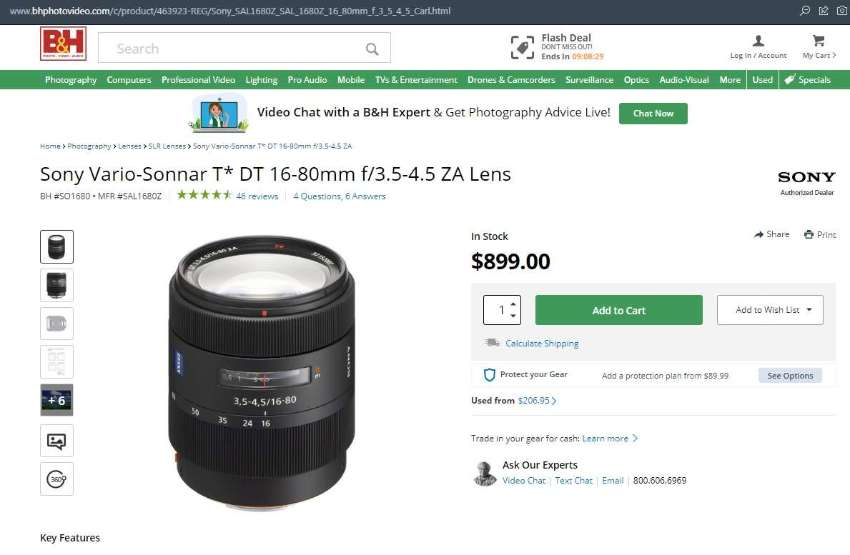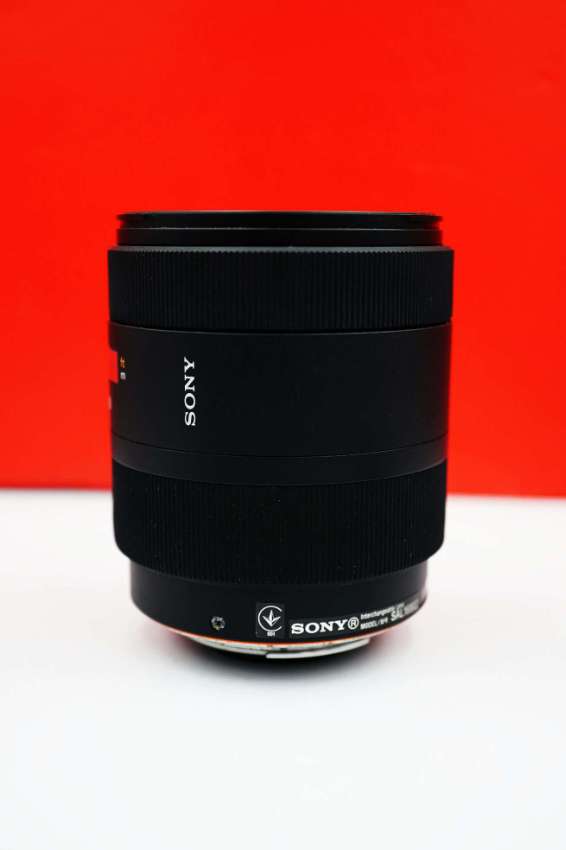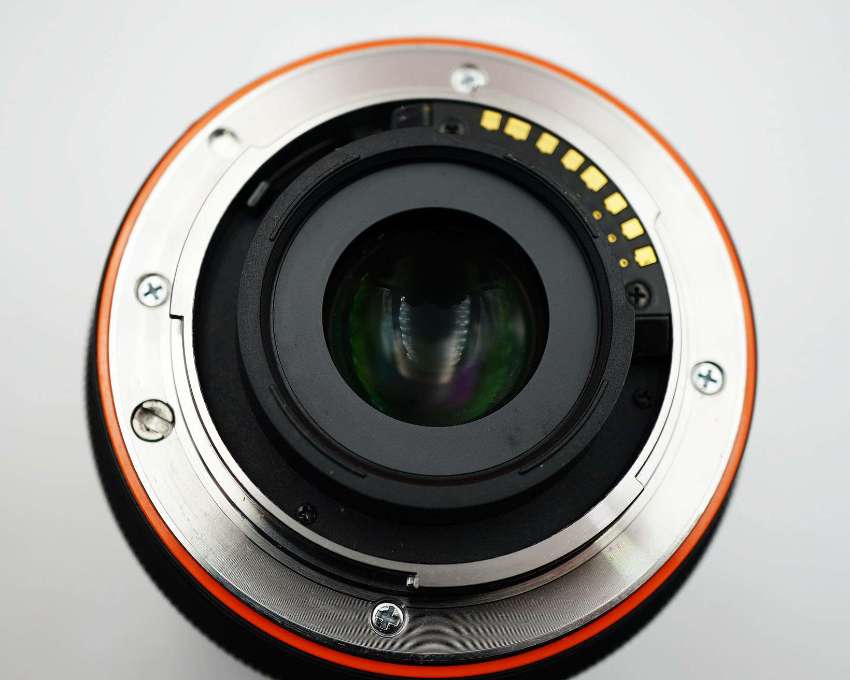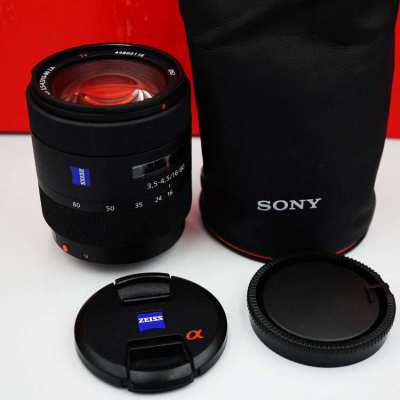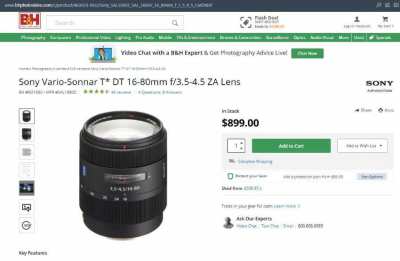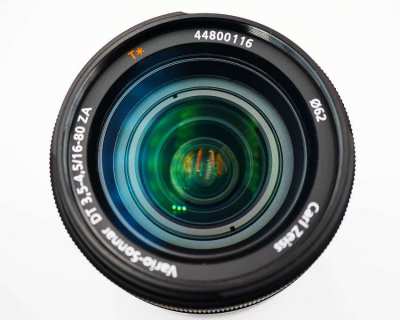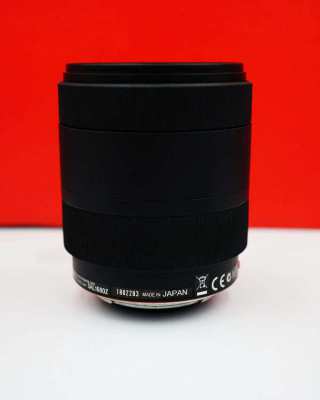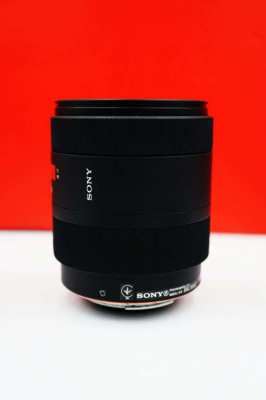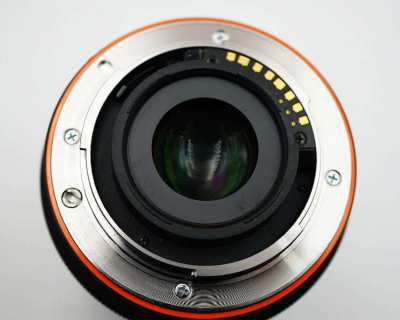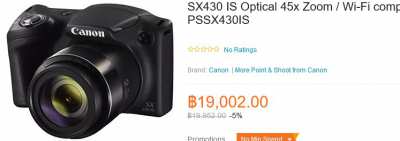Sony Carl Zeiss Vario-Sonnar T* DT 16-80mm f/3.5-4.5 ZA Lens, 24-120mm
- กลางเมืองพัทยา
- 20 May 2024 : 17:59 pm
- ไอดี: 476724
รายละเอียดของโฆษณา
https://www.youtube.com/watch?v=ivZrAATdAUo
Possibly the first zoom you’ll need.
The SAL1680Z is a superb single-lens solution for many APS-C format photographers. Its 35mm equivalent 24-120mm range may be all you’ll ever need for day-to-day shooting. And of course it delivers acclaimed ZEISS optical performance and handling, with image quality that rivals the best prime lenses at any focal length. An ideal introduction to ZEISS quality for A-mount APS-C format bodies.
For Sony A-Mount cameras:
Professional Full frame: α900 α99 α99 II α850
APS-C High-end: DG-7D α700 α77 α77 II
Midrange: α65 α68
Upper-entry: α55 α57 α100 α550 α580 α58 DG-5D α500 α560 α450
Entry-level: α33 α35 α37 α350 α380 α390 α300 α330 α200 α230 α290
For Sony E-Mount cameras with adapter!
Made in JAPAN. Very good working condition!
Includes : Lens, two caps, Sony Soft Lens Bag.
S/n: last photo.
EMS 50 baht, Cash on Delivery Available (COD เก็บเงินปลายทางได้)
or meeting in North Pattaya.
More photos and questions via Line ID: gnnick
https://www.sony-asia.com/electronics/camera-lenses/sal1680z
Sony Vario-Sonnar T* DT 16-80mm f/3.5-4.5 ZA Overview
Have all your bases covered with the Vario-Sonnar T* DT 16-80mm f/3.5-4.5 ZA Lens from Sony, which offers an extremely versatile 24-120mm equivalent zoom range on APS-C format A-mount cameras. Benefitting from a Zeiss design that incorporates two aspherical elements and the renowned T* coating, this zoom will help capture sharp, aberration-free images. Also, due to the use of a variable f/3.5-4.5 maximum aperture the overall size and weight is kept to a minimum. Handling and operation is intuitive, especially with an Auto Clutch mechanism that prevents the focusing ring from rotating when autofocus is engaged. Additionally, the internally focusing lens has a minimum focus distance of 1.1' and it has a seven-blade circular diaphragm for smooth bokeh.
Based on the Zeiss Sonnar optical concept, this lens uses a design with 14 elements in 10 groups that helps provide a maximum aperture range of f/3.5-4.5 while simultaneously reducing flare and improving contrast.
A standard-length zoom designed for Sony A-mount APS-C-format cameras, the 16-80mm will provide a versatile wide-angle to telephoto 24-120mm equivalent focal length.
Two aspherical elements are incorporated in the lens design to reduce astigmatism, field curvature, coma, and other monochromatic aberrations.
Zeiss T* anti-reflective coatings have been applied to each lens surface to help minimize reflections in order to provide greater image clarity, contrast, and color fidelity.
An Auto Clutch mechanism prevents the focusing ring from rotating when the lens is set to autofocus, allowing for easier, and more natural feeling control over the lens.
An internal focus design enables fast autofocus as well as a minimum focus distance of 1.1'.
Rounded seven-blade diaphragm contributes to a pleasing bokeh quality when employing selective focus techniques.
About this item
● 5x zoom designed specifically for DSLR APS-size
● Superb performance from wide angle to telephoto
● 2 glass-molded aspherical lenses for extra precision
● Circular aperture for pleasing defocused effects.Equivalent 35mm when mounted on an APS format DSLR - 24 - 120mm
● Auto clutch to stop manual focus ring rotation, wide focus ring for a solid feel in manual focusing
Vario-Sonnar T* DT 16-80mm F3.5-4.5 ZA Zoom Lens
The lightest and most compact zoom in the Carl Zeiss lineup, this lens offers the greatest zoom range making it a superb single-lens solution for many photographers. It delivers acclaimed Carl Zeiss optical performance and handling with image quality that rivals the best prime lenses at any focal length.
Technology
Circular Aperture
When changing your aperture to defocus the background, the light sources appear blurred. This ‘bokeh’ effect of the blurred background can be enhanced with circular aperture blades used in this lens. Conventional aperture blades have flat sides creating unappealing polygonal shaped defocussed points of light. α lenses overcome this problem through a unique design that keeps the aperture almost perfectly circular from its wide-open setting to when it is closed by 2 stops. Smoother, more natural defocusing can be obtained as a result.
Aspherical lens elements
Aspherical lens design dramatically reduces spherical aberration while also reducing lens size and weight. Spherical aberration is a slight misalignment of the light rays projected on the image plane. This is caused by differences in refraction at different points on conventional spherical lenses which degrade image quality in large-aperture lenses. Specially shaped “aspherical” elements near the diaphragm restore alignment of light rays at the image plane, maintaining high sharpness and contrast even at maximum aperture and can also be used at other points in the optical path to reduce distortion. Well-designed aspherical elements can reduce the total number of elements required in the lens, thus reducing overall size and weight. Advanced Aspherical (AA) elements are an evolved variant, featuring an extremely high thickness ratio between the center and periphery. AA elements are exceedingly difficult to produce, relying on the most advanced molding technology to consistently and precisely achieve the required shape and surface accuracy, resulting in significantly improved image accuracy and quality.
Carl Zeiss T* (T-star) coating
Coated optics were pioneered by Carl Zeiss - and this superb lens features the Carl Zeiss T* (T-Star) coating that virtually eliminates lens flare, internal reflection and light scattering that can otherwise occur at glass-to-air surfaces. The T* coating contributes to outstanding image quality, with high contrast and uniformly excellent resolution right out to the image edges. Not simply applied to any lens - the T* symbol only appears on multi-element lenses in which the required performance has been achieved throughout the entire optical path, therefore guaranteeing the highest quality.
Distance encoder
The distance encoder plays an integral part in ADI flash metering, which delivers high precision flash metering that is unaffected by the reflectance of subjects or backgrounds. The distance encoder is a lens component that directly detects the position of the focusing mechanism, and sends a signal to the CPU in order to measure distance to the subject. During flash photography, this data is very useful in calculating how much flash output is appropriate to the scene.
Additional Features
Internal focusing
Only the middle groups of the optical system move to achieve focus, so the overall length of the lens does not change. Other important benefits include fast autofocusing and a short minimum focusing distance. Also, the filter thread at the front of the lens does not rotate, which is convenient if you’re using a polarizing filter.
Possibly the first zoom you’ll need.
The SAL1680Z is a superb single-lens solution for many APS-C format photographers. Its 35mm equivalent 24-120mm range may be all you’ll ever need for day-to-day shooting. And of course it delivers acclaimed ZEISS optical performance and handling, with image quality that rivals the best prime lenses at any focal length. An ideal introduction to ZEISS quality for A-mount APS-C format bodies.
For Sony A-Mount cameras:
Professional Full frame: α900 α99 α99 II α850
APS-C High-end: DG-7D α700 α77 α77 II
Midrange: α65 α68
Upper-entry: α55 α57 α100 α550 α580 α58 DG-5D α500 α560 α450
Entry-level: α33 α35 α37 α350 α380 α390 α300 α330 α200 α230 α290
For Sony E-Mount cameras with adapter!
Made in JAPAN. Very good working condition!
Includes : Lens, two caps, Sony Soft Lens Bag.
S/n: last photo.
EMS 50 baht, Cash on Delivery Available (COD เก็บเงินปลายทางได้)
or meeting in North Pattaya.
More photos and questions via Line ID: gnnick
https://www.sony-asia.com/electronics/camera-lenses/sal1680z
Sony Vario-Sonnar T* DT 16-80mm f/3.5-4.5 ZA Overview
Have all your bases covered with the Vario-Sonnar T* DT 16-80mm f/3.5-4.5 ZA Lens from Sony, which offers an extremely versatile 24-120mm equivalent zoom range on APS-C format A-mount cameras. Benefitting from a Zeiss design that incorporates two aspherical elements and the renowned T* coating, this zoom will help capture sharp, aberration-free images. Also, due to the use of a variable f/3.5-4.5 maximum aperture the overall size and weight is kept to a minimum. Handling and operation is intuitive, especially with an Auto Clutch mechanism that prevents the focusing ring from rotating when autofocus is engaged. Additionally, the internally focusing lens has a minimum focus distance of 1.1' and it has a seven-blade circular diaphragm for smooth bokeh.
Based on the Zeiss Sonnar optical concept, this lens uses a design with 14 elements in 10 groups that helps provide a maximum aperture range of f/3.5-4.5 while simultaneously reducing flare and improving contrast.
A standard-length zoom designed for Sony A-mount APS-C-format cameras, the 16-80mm will provide a versatile wide-angle to telephoto 24-120mm equivalent focal length.
Two aspherical elements are incorporated in the lens design to reduce astigmatism, field curvature, coma, and other monochromatic aberrations.
Zeiss T* anti-reflective coatings have been applied to each lens surface to help minimize reflections in order to provide greater image clarity, contrast, and color fidelity.
An Auto Clutch mechanism prevents the focusing ring from rotating when the lens is set to autofocus, allowing for easier, and more natural feeling control over the lens.
An internal focus design enables fast autofocus as well as a minimum focus distance of 1.1'.
Rounded seven-blade diaphragm contributes to a pleasing bokeh quality when employing selective focus techniques.
About this item
● 5x zoom designed specifically for DSLR APS-size
● Superb performance from wide angle to telephoto
● 2 glass-molded aspherical lenses for extra precision
● Circular aperture for pleasing defocused effects.Equivalent 35mm when mounted on an APS format DSLR - 24 - 120mm
● Auto clutch to stop manual focus ring rotation, wide focus ring for a solid feel in manual focusing
Vario-Sonnar T* DT 16-80mm F3.5-4.5 ZA Zoom Lens
The lightest and most compact zoom in the Carl Zeiss lineup, this lens offers the greatest zoom range making it a superb single-lens solution for many photographers. It delivers acclaimed Carl Zeiss optical performance and handling with image quality that rivals the best prime lenses at any focal length.
Technology
Circular Aperture
When changing your aperture to defocus the background, the light sources appear blurred. This ‘bokeh’ effect of the blurred background can be enhanced with circular aperture blades used in this lens. Conventional aperture blades have flat sides creating unappealing polygonal shaped defocussed points of light. α lenses overcome this problem through a unique design that keeps the aperture almost perfectly circular from its wide-open setting to when it is closed by 2 stops. Smoother, more natural defocusing can be obtained as a result.
Aspherical lens elements
Aspherical lens design dramatically reduces spherical aberration while also reducing lens size and weight. Spherical aberration is a slight misalignment of the light rays projected on the image plane. This is caused by differences in refraction at different points on conventional spherical lenses which degrade image quality in large-aperture lenses. Specially shaped “aspherical” elements near the diaphragm restore alignment of light rays at the image plane, maintaining high sharpness and contrast even at maximum aperture and can also be used at other points in the optical path to reduce distortion. Well-designed aspherical elements can reduce the total number of elements required in the lens, thus reducing overall size and weight. Advanced Aspherical (AA) elements are an evolved variant, featuring an extremely high thickness ratio between the center and periphery. AA elements are exceedingly difficult to produce, relying on the most advanced molding technology to consistently and precisely achieve the required shape and surface accuracy, resulting in significantly improved image accuracy and quality.
Carl Zeiss T* (T-star) coating
Coated optics were pioneered by Carl Zeiss - and this superb lens features the Carl Zeiss T* (T-Star) coating that virtually eliminates lens flare, internal reflection and light scattering that can otherwise occur at glass-to-air surfaces. The T* coating contributes to outstanding image quality, with high contrast and uniformly excellent resolution right out to the image edges. Not simply applied to any lens - the T* symbol only appears on multi-element lenses in which the required performance has been achieved throughout the entire optical path, therefore guaranteeing the highest quality.
Distance encoder
The distance encoder plays an integral part in ADI flash metering, which delivers high precision flash metering that is unaffected by the reflectance of subjects or backgrounds. The distance encoder is a lens component that directly detects the position of the focusing mechanism, and sends a signal to the CPU in order to measure distance to the subject. During flash photography, this data is very useful in calculating how much flash output is appropriate to the scene.
Additional Features
Internal focusing
Only the middle groups of the optical system move to achieve focus, so the overall length of the lens does not change. Other important benefits include fast autofocusing and a short minimum focusing distance. Also, the filter thread at the front of the lens does not rotate, which is convenient if you’re using a polarizing filter.


